Gigabyte GA-EP45-UD3P - P45 at its Finest
by Gary Key on February 3, 2009 12:15 AM EST- Posted in
- Motherboards
Board Layout
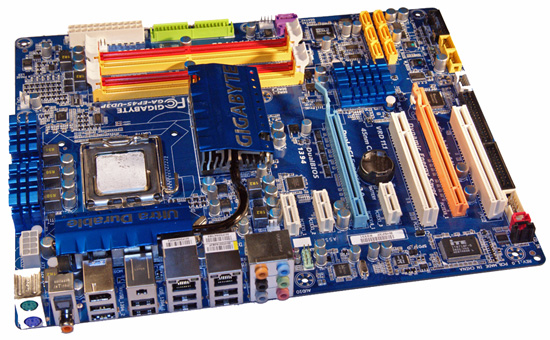
Taking a quick tour around this board, we find the overall layout is excellent. The 24-pin and 8-pin ATX power connectors, floppy/IDE connectors, and several of the SATA ports are all placed along the edge of the motherboard. We would have preferred that the SATA connectors were in a 90 degree angle configuration, but they work as is. One nice feature is that there is a double slot gap between the two physical PCI-E x16 slots so that aftermarket cooling will work. Installation of our peripherals was easy and the board fit well in several case designs. The back of the board is clean and all of our various air coolers that required a back plate worked fine. Let’s take a quick look at the rest of the board.
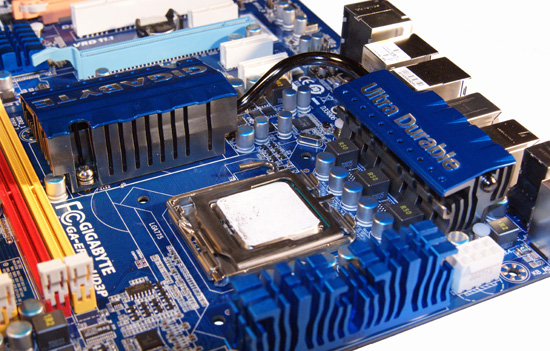
The CPU socket area is open and unobstructed for the most part. The socket area is surrounded by the Northbridge heatsink, MOSFET coolers, and several capacitors, but we had no issue installing large air coolers or a couple of water blocks. This board features a six-phase power design with three Low RDS(on) MOSFETs per channel along with the R50 ferrite core closed chokes.
Forget the marketing info about eight to sixteen phase power delivery systems; it is all about the quality of the components utilized. This board supports 30A per phase and delivers a total of 180A to the CPU. This is more than enough for any Core 2 processor in Intel’s lineup, even with heavy overclocking.
The chipset and MOSFET cooling system is well designed and works. Gigabyte connects the aluminum Northbridge heatsink to the primary MOSFET heatsink with a revised heatpipe design. The second MOSFET heatsink located on the edge of the board reminds us of Intel’s BadAxe designs. To answer the question of whether any of this works: yes, it works very well even with the system overclocked.
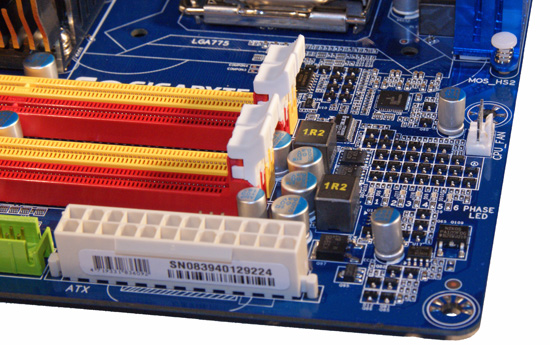

The top picture shows the phase LED setup that displays the number of power phases in use, but only when the Dynamic Energy Saver software is running. Located below the LED panel is the two-phase power system for the memory slot along with the CPU fan header that is slightly out of the way for us.
The second image shows the eye popping red and yellow memory slots. Fortunately for most of us, Gigabyte has changed to a muted color scheme on the X58 boards, but the Crayola color scheme lives on in this board. The floppy drive connector, 24-pin ATX power connector, and the two GSATA ports are located along the edge of the board.
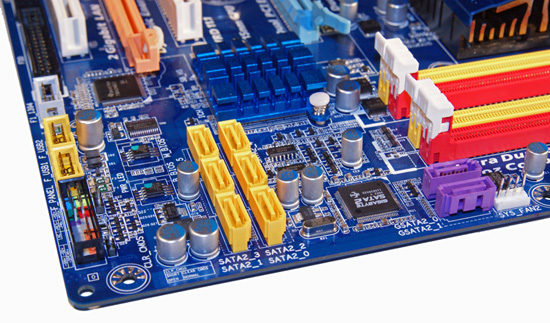
Hey, the two purple GSATA ports show up again. This rebranded JMicron controller is capable of RAID 0 and RAID 1 operation. Intel’s ICH10R provides support for the six yellow SATA ports and features RAID 0/1/5/10 capabilities with Intel’s excellent Matrix technology. The ICH10R is cooled by a low-rise aluminum heatsink . Along the left edge of the board is the black front panel connector, two yellow USB 2.0 headers, and the gray IEEE 1394a header.
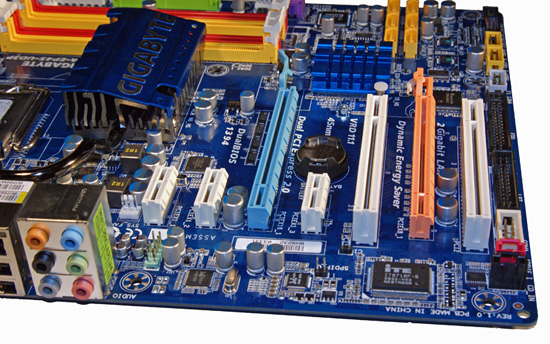
The expansion slot layout is very good and indicates that Gigabyte has been listening to users. The third PCIe x1 slot and second PCI slot become physically unusable if dual-slot graphics cards are placed in the PCIe x16 slots. Even so, with a CrossFire setup you end up with two PCIe x1 and one PCI slot open. You cannot ask for much more than that.
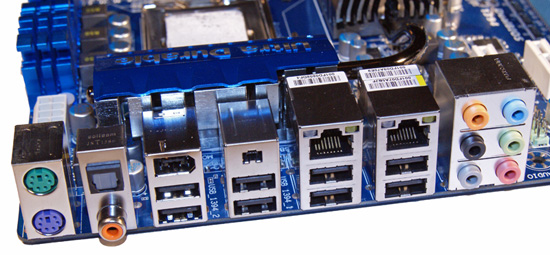
Last but certainly not least is the I/O panel. There are the standard issue PS/2 keyboard and mouse ports, two Gigabit LAN ports with LED activity lights, eight USB 2.0 ports, two IEEE 1394a ports, optical and coaxial S/PDIF ports, and an audio panel.
















73 Comments
View All Comments
GhettoFly - Tuesday, February 3, 2009 - link
I'm guessing the 1250 kit you guys managed to clock at 1300 was Corsair's TWIN2X2048-10000C5DF. I have a set of those, but haven't tested with my UD3P yet; however I got my Geil DDR2-1160 C4 kit up to DDR2-1333 C5 on this board with only 2.48V using the 1333 OC profile: http://i4memory.com/f90/gigabyte-ep45-ud3p-memory-...">http://i4memory.com/f90/gigabyte-ep45-ud3p-memory-...This board is too much fun!
Gary Key - Wednesday, February 4, 2009 - link
Yes, it is the Corsair kit and it was an early review sample to boot. Corsair sent us a new SPD and I managed to hit 1333 this morning at 2.50V on it, so I can report that 1333 is stable on this board now after a few runs of Crysis and PCMark Vantage. :)GhettoFly - Wednesday, February 11, 2009 - link
It just seems a bit odd advertising DDR2-1366+ OC capabilities when the ICs needed for such clocks (D9GMH/GKX) are EOL :px86 64 - Sunday, February 15, 2009 - link
I'm still seeing some around and very cheap compared to what they used to be. You can pick up two 2x1GB (4GB) kits of PC2-10400 or PC2-9600 for under $275-$300 US.I think there are third party manufacturers who are still making the D9GMH\GKX, etc, because companies like Cellshock (now recently defunct) and Team Group (active) are still selling both of the most popular flavors of D9. Team is very big in Asia so it's not like they are some small niche company like Cellshock moving a small quantity of old stock. All of Team Group's Xtreem memory (not the "Dark" branding) is either GMH or GKX. How else to explain the constant flow of Micron D9 IC's to certain companies? Could there be that much stock still left over in Asia where they are selling them this long after they were discontinued?? I would be surprised.
GhettoFly - Sunday, February 15, 2009 - link
It has to be old stock of the ICs at least; when you look at the codes on the ICs themselves (not the D9Gxx code, but like 7KD22) I'm pretty sure the first number indicates the year of manufacture, 7 being 2007, 6 being 2006, etc. I haven't see any Micron RevD chips that have those codes staring with 8 even on sticks with a 2008 production date, for example my Geil 1160 C4 and Team Xtreem 9600 kits, the ICs on both have that code starting with a 7.Mr Roboto - Wednesday, February 18, 2009 - link
I don't know what the number is on the IC's themselves but you can check the manufacture date of your memory using a monitoring program like Everest.I have a set of Team's and using Everest they say the 14th week of 2008 as the date or manufacture.
Whether or not the IC's were made then or the modules themselves is debatable.
x86 64 - Sunday, February 15, 2009 - link
I think you might be right. I just pulled the spreaders off my Team 1200Mhz and sure enough it starts with a 7. I hope they don't run out anytime soon because it's so much fun to push this stuff :)It's weird, this has to be the first time in a long time that I'm happy with "last generation" hardware. I just don't see the benefit of i7 and DDR3 right now. I'm enjoying the rock solid P45, excellent inexpensive dual and quad Penryn's and dirt cheap high performance memory. I'd rather buy double the current hardware then spend the same amount for an entry level i7 system and get a 20% increase in performance. I'm sure the i7 will make a great server or HPC but I'm not impressed to much with the desktop parts. We need some multithreaded applications first. Software is seriously lagging.
I'll wait for the die shrink and in the mean time stick with my DDR2 and D9GKX\GMH :)
x86 64 - Sunday, February 15, 2009 - link
Also here's a picture of a TG kit from a review at XBit Labs from the summer of 2007 and it's marked with a 6 which would be in line with the markings on the recent chips, just one year back.http://www.xbitlabs.com/images/memory/team-xtreem/...">http://www.xbitlabs.com/images/memory/team-xtreem/...
GhettoFly - Wednesday, February 18, 2009 - link
Looks like I have to eat my words about no D9 being manufactured in 2008, these are powering the G.Skill 2GBHK sticks I got in today.http://www.xtremesystems.org/forums/showpost.php?p...">http://www.xtremesystems.org/forums/showpost.php?p...
Glenn - Tuesday, February 3, 2009 - link
Great article Gary! I have built approximately 10 systems so far with this board or it's single PCIe X16 twin UD3R, and the "C" version with the DDR3/DDR2 slots. My experiences with each are just as pleasing as you have reported. My own system is the C version with a Q9550 slightly overclocked to 3.4GHz. I am excited to see the followup on the Ultra Durable 3 technology.I am equally or even more excited that you are testing the support of Gigabyte and other manufacturers. I have built over 100 systems using gigabyte P35/G35 and now P45/G45 boards in the past year and a half and I honestly nearly quit using them over some issues with the G45 board when it was first released. It wasn't even close to stable but subsequent bios'es corrected all my complaints. I could get no response from Gigabyte during that time and was pretty pist off! Interestingly enough, I just about switched all my builds to Asus, but I was reminded of past problems with them on my first P45Q build when I went to download the newest drivers! Why does a multibillion dollar company like Asus insist on having a dog-assed slow website that is so painful to negotiate? At times during the day, one can't even get a page to open without timing out! And it's been that way for years! Gigabyte! You owe Asus a "save" on that one! Kudos to Anands crew for taking up these frustrations with the mfgs! Great article!